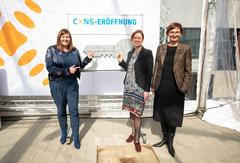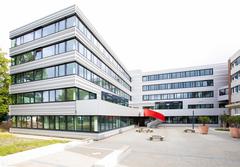URL: https://www.desy.de/news/news_search/index_eng.html
Breadcrumb Navigation
DESY News: Three research ministers open Centre for X-ray and Nano Science at DESY
News
News from the DESY research centre
Three research ministers open Centre for X-ray and Nano Science at DESY
A symbol of cutting-edge research: today, no fewer than three research ministers opened the Centre for X-ray and Nano Science (CXNS) at DESY in Hamburg. Federal Research Minister Bettina Stark-Watzinger, Hamburg’s Science Senator Katharina Fegebank and Schleswig-Holstein’s Minister of Education Karin Prien handed over the keys to the new multistate research building to its new occupants: Kiel University, the Helmholtz Centre Hereon and DESY. The CXNS is a multi-institutional, interdisciplinary platform for research using X-rays in combination with nano and material sciences and is one of a kind. The centre benefits, among other things, from its proximity to the high-brilliance X-ray source PETRA III and will also provide a home for further collaborative projects.

Katharina Fegebank, Science Senator of the City of Hamburg, Karin Prien, Minister of Science in Schleswig-Holstein, and Federal Research Minister Bettina Stark-Watzinger (from left) at the Grand Opening of the new Centre for X-ray and Nano Science (CXNS) at DESY. Photo: DESY, Daniel Reinhardt
Federal Research Minister Bettina Stark-Watzinger explains that “basic research investigates the fundamental questions of our world and is constantly making new discoveries. It gathers knowledge that flows into our innovation pipeline, which we so urgently need in order to tackle major challenges, such as pandemics and climate change. The CXNS is a research centre unlike any other. The Federal Government has contributed more than 15 million euros of the total investment for the building. In doing so, we are reinforcing this site and laying the foundations for an effective regional innovation ecosystem that will be an international leader. The proximity to DESY’s start-up environment should also ensure that ideas arising from research are turned into practical applications more swiftly.”
Hamburg’s Science Senator Katharina Fegebank says: “I am delighted to be inaugurating the Centre for X-ray and Nano Science as a further jewel for our Science City Hamburg Bahrenfeld. The centre provides a state-of-the-art laboratory infrastructure and will undoubtedly produce ground-breaking, innovative ideas. Fascinating approaches already exist, in the field of hydrogen storage, for example, which could be real game changers in the energy transition. And that is just the beginning. Science City Hamburg Bahrenfeld will provide ideal conditions for this valuable cooperation between different research institutions. We can be sure that once again cutting-edge research is being conducted here in Hamburg as a centre for science!”
Schleswig-Holstein’s Minister of Science Karin Prien describes the new research building as a “house of opportunities”. “Ideas will be developed and put to the test here with which we can shape the world of tomorrow. The highly sophisticated measuring techniques available on the DESY campus provide the best possible conditions for breakthroughs in the field of new materials. Materials that will help us meet the challenges of the future.” At the same time, she said, the CXNS is a place of international cooperation, “and thereby shows that in order to be able to exploit existing scientific potential, we will need cosmopolitanism and cooperative thinking in the future as well.”
The new five-storey building has a floor area of over 5000 square metres, more than 700 square metres of which takes the form of laboratories. It offers room for some 250 employees. The CXNS houses DESY NanoLab, the “German Engineering Materials Science Centre” of the Helmholtz Centre Hereon, parts of the “Ruprecht Haensel Laboratory” of Kiel University, as well as a cooperative venture between DESY and the Technical University of Hamburg as part of the interdisciplinary “Centre for Integrated Multiscale Materials Systems” and a branch of the Leibniz Institute for Crystal Growth. In addition, other groups working at DESY’s Photon Science department will use laboratories and office space in the building. The CXNS offers ideal conditions for nano and materials research using photons and complementary methods. High-tech laboratories that resort to mutually enhancing, networked methods of analysis and research are concentrated here in a single place and directly connected to DESY’s large-scale research facilities.
“By combining the competencies of DESY, Hereon and CAU, the CXNS will become a unique platform for developing and studying new materials, new sensor technologies and catalysts for chemical processes. This will allow us to develop approaches to solutions for important issues, which our society so urgently needs, and lay the foundations for the innovations of tomorrow,” says Professor Helmut Dosch, Chairman of the DESY Board of Directors, who commissioned the building.
DESY NanoLab is DESY’s centre for nano research and its technically sophisticated laboratories provide ideal conditions for structuring, manufacturing, characterising and labelling nanospecimens, which are then studied in the high-intensity X-rays of the research radiation sources PETRA III, FLASH or European XFEL. The highly sensitive laboratory equipment needed for this will stand on separate foundations inside the building, specially decoupled to prevent extraneous vibrations, and the fragile samples can be transferred to the PETRA experiment hall “Max von Laue” by the shortest route.
The scientists from the Helmholtz Centre Hereon will be using the new building for their “German Engineering Materials Science Centre” (GEMS). “At the Helmholtz Centre Hereon we are developing technologies to shape the necessary shift towards greater sustainability. Our fields of research include lightweight construction and medical technologies, hydrogen technologies and membranes for drinking water treatment. The characterisation methods available at the CXNS are unique in the world and will allow us to understand processes and materials right down to the atomic level, thereby building a bridge from fundamental research, via digital twins, all the way to new innovations,” explains Professor Matthias Rehahn, Scientific Director at Hereon.The Ruprecht Haensel Laboratory has existed for many years as a successful joint venture between Kiel University, with its research focus “Kiel Nano, Surface and Interface Science” (KiNSIS), and DESY. For the most part, structural, electronic and dynamic properties of materials are investigated there using photons. The President of Kiel University, Professor Simone Fulda, notes that “The Ruprecht Haensel Laboratory is the physical interface of this long-standing cooperation between large-scale research, top-level university research and research-related teaching. Due to their direct proximity to PETRA III, the offices in the CXNS offer our working groups in the field of nano, life and surface sciences ideal conditions for developing innovative instruments and methods for nano-research and for exploring complex materials.” The laboratory is named after Ruprecht Haensel, one of the most important pioneers of research using synchrotron radiation. In the 1960s, he characterised this type of radiation at the DESY synchrotron, thereby making its huge research potential accessible. He was the rector of Kiel University from 1996 to 2000.
The total cost of the building was approximately 18 million euros and has come from federal funds (15 million euros), the states of Hamburg and Schleswig-Holstein, and from the regular budgets of the three research institutions involved.




